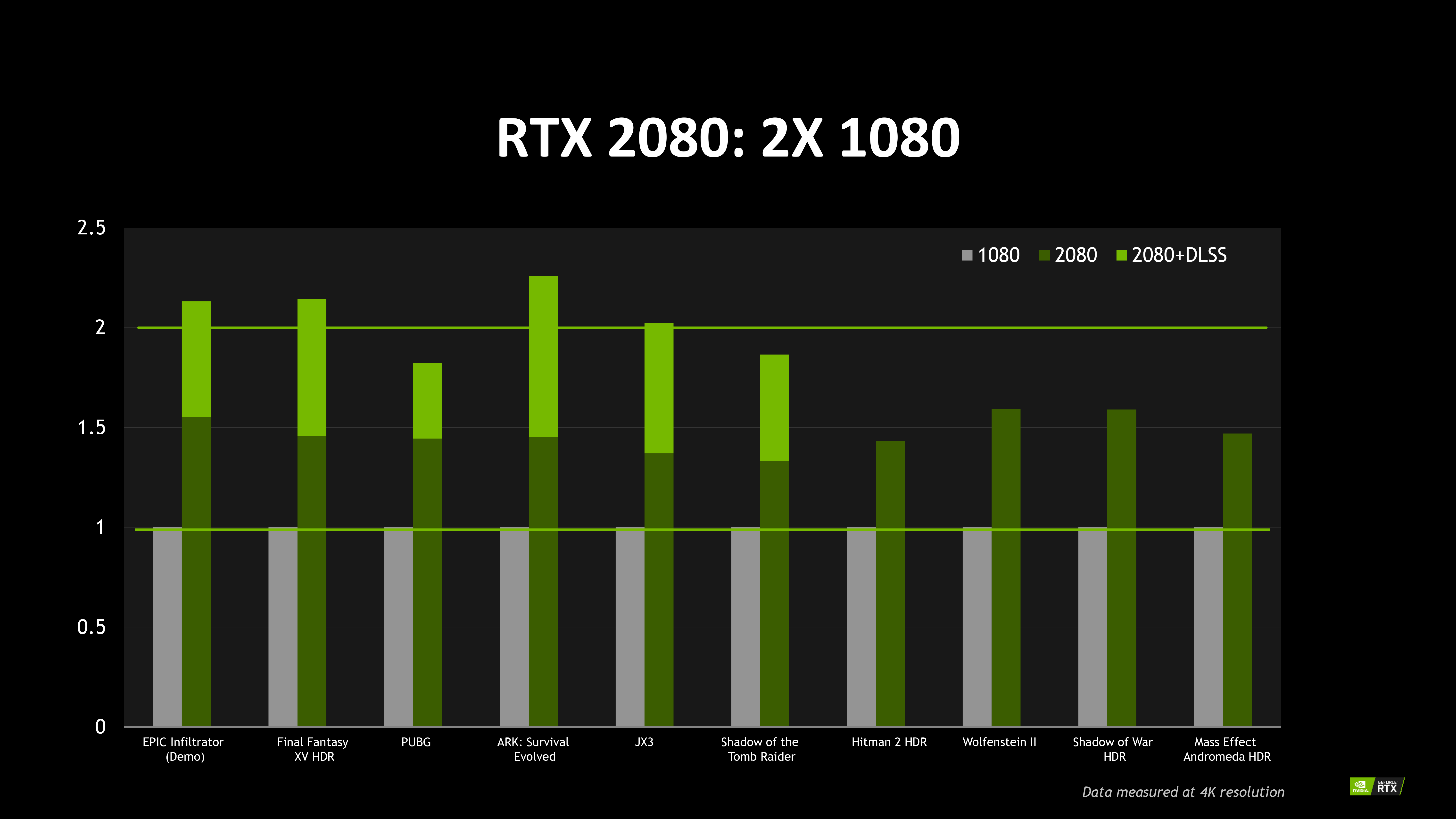
In a transfer that basically ought to have occurred on Monday, Nvidia have lastly launched some figures relating to how a lot better their new Turing RTX 2080 card is in comparison with their present large body hitter, the Nvidia GeForce GTX 1080. Some, that means a handful of very particular numbers for under a choose variety of games, at 4K, 60Hz, with no point out of graphics high quality.
Still! Numbers! And some fairly decent-ish ones too, contemplating the fairly nebulous circumstances. Let’s have a look.
RTX 2080 vs GTX 1080: efficiency
Of course, with out figuring out what sort of graphics settings Nvidia used to acquire these figures, the next numbers and stats clearly solely paint a really small image of what the RTX 2080 is actually able to. Full judgement must be reserved till evaluate samples can be found, however within the ten games Nvidia did discuss, you may most likely anticipate to see roughly 1.5x the efficiency of a GTX 1080.
That’s throughout Epic’s uber demanding Unreal Engine 4 Infiltrator demo, Final Fantasy XV with HDR switched on, Plunkbat, ARK: Survival Evolved, JX3, Shadow of the Tomb Raider, Hitman 2 with HDR, Wolfenstein II: The New Colossus, HDR-ified Middle-earth: Shadow of War, and Mass Effect Andromeda, additionally with HDR – as illustrated by the graph under (click on to enlarge).

It’s unclear what settings Nvidia used to get these efficiency stats, and what sort of body charges that equates to, however what’s actually astonishing is the velocity increase supplied by Turing’s different large function, Deep Learning Super Sampling (the sunshine inexperienced bar)
You’ll most likely discover that some games in that there slide have an additional gentle inexperienced bar on prime of them. To make issues further complicated, that’s the type of efficiency improve you may anticipate – round 2x a GTX 1080 – in games that help Turing’s fairly cool Deep Learning Super Sampling tech (or DLSS).
Without getting too slowed down within the technical nitty-gritty, DLSS primarily applies the identical type of AI and deep studying know-how to rendering strategies (leading to these crisp, easy edges everybody’s so keen on) as Turing’s ray tracing stuff does to, nicely, ray tracing.
If all that sounds a bit doubtful, belief me, it’s not. At an Nvidia press occasion right now I noticed DLSS in motion, the place Nvidia used that aforementioned Infiltrator demo to indicate the way it compares to straightforward temporal anti-aliasing (TAA). With a GTX 1080Ti working on one facet of the display screen utilizing TAA, and the RTX 2080Ti working with DLSS enabled on the opposite, the RTX 2080Ti was certainly working at twice the velocity of its GTX predecessor, with solely a really marginal, virtually imperceptible dip in total high quality as well.
This would seem to substantiate Nvidia’s claims of double efficiency with DLSS (regardless of utilizing the Ti model of the RTX 2080 as an alternative of the common one talked about within the slide), and would most likely go a good distance to assist justify the cardboard’s monumental worth – supplied you want/find yourself enjoying the games that really help it.
RTX 2080 vs GTX 1080: body charge benchmarks
Of course, 1.5x or 2x the velocity of a GTX 1080 means nothing with out some concrete numbers. Or a minimum of as concrete as you may get when Nvidia solely launch numbers for a really restricted variety of games in the mean time (which, fairly unhelpfully, aren’t fairly the identical games listed above) with no point out in any way of what graphics settings they used to report them, or certainly whether or not ray tracing was in impact, or DLSS was engaged.
But! If you have been hoping the RTX 2080 would possibly lastly provide a single GPU answer for enjoying games at 4K at 60fps in HDR, you might nicely discover these body charges fairly extra hopeful than the 60fps 1080p targets Metro Exodus is aiming to hit with ray tracing switched on. Here’s what you’re taking a look at:
- Final Fantasy XV: 60fps
- Hitman: 73fps
- Call of Duty WWII: 93fps
- Mass Effect Andromeda: 67fps
- Star Wars Battlefront II: 65fps
- Resident Evil VII: 66fps
- F1 2017: 72fps
- Destiny 2: 66fps
- Battlefield 1: 84fps
- Far Cry 5: 71fps
To put a minimum of a kind of figures into perspective, you might bear in mind from my Final Fantasy XV PC performance analysis that even the GTX 1080Ti struggled to run it at something a lot past 45fps at 4K on its Highest preset, which makes the RTX 2080’s determine of 60fps appear fairly spectacular. That mentioned, the GTX 1080Ti might additionally attain speeds as excessive as 55fps after I dropped the issues all the way down to Average, which might be fairly damning if Nvidia did certainly get their 60fps RTX 2080 determine utilizing the identical graphics setting. We simply don’t know at this level.
Still, as an preliminary indicator, the RTX 2080’s efficiency appear promising. Perhaps not a grand’s price of promising, all informed, however I received’t have the ability to say in some way till I’ve been ready put it by its correct paces. One factor you may assure, although, is that I’ll scrutinizing each final determine like a hawk as quickly as I’m bodily in a position to do. Stay tuned.

